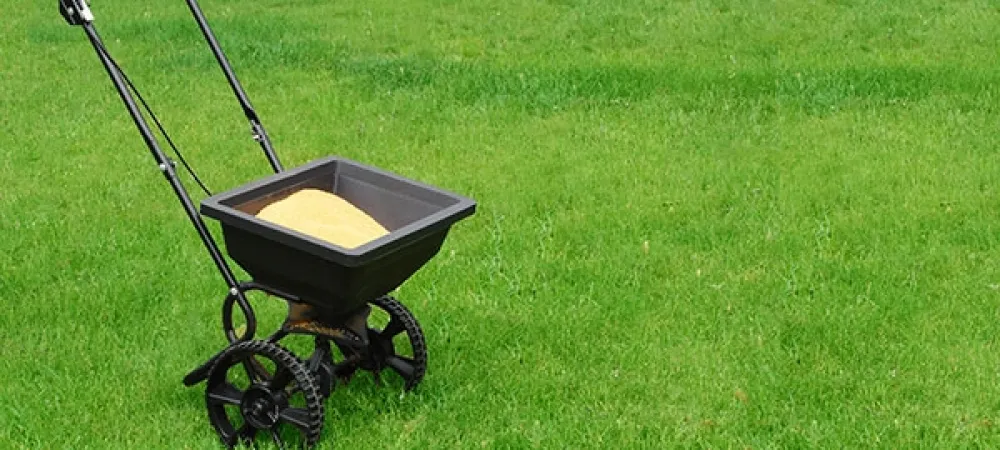How Often Should You Fertilize Your Lawn in Spring

Spring marks the beginning of the growing season, and for your lawn, that means it’s time to wake up, green up, and grow strong. Fertilizing during this critical window helps your grass shake off dormancy and build the foundation for a healthy, full yard all season long.
Fertilizer delivers essential nutrients that support color, thickness, and root strength—but when and how often to apply it can be confusing. Every lawn is different, and the ideal plan depends on your goals, grass type, and season climate. Learn how to create the perfect strategy with expert tips from local lawn care experts.
Can I Fertilize My Lawn Every 2 Weeks?
Some homeowners wonder if fertilizing frequently will make their lawn grow faster and look better—but in most cases, fertilizing every two weeks is not recommended.
Here are a few reasons why:
- Grass burn from excess nitrogen.
- Excessive top growth that stresses roots and increases mowing needs.
- Nutrient runoff into storm drains and local waterways.
High-frequency fertilization is sometimes used for golf courses or under professional programs, but these situations involve tightly controlled conditions. For residential lawns, over-fertilizing is more likely to cause damage than improvements.
How Many Times Should I Fertilize My Lawn in Spring?
In general, homeowners should fertilize 1 to 2 times during spring, depending on grass type, soil condition, and how quickly you want your lawn to thicken up.
Here’s a typical spring fertilization timeline:
- First application: When soil temperatures reach around 55°F—usually mid-March to early April.
- Second application (if needed): About 6–8 weeks after the first, in late April or May.
This spacing gives your lawn a steady release of nutrients without overloading it.
What is a Good Spring Fertilizer Schedule?
A well-timed fertilizer schedule is key to building a strong, green lawn heading into summer. Knowing your type of grass is a crucial factor in your schedule. For warm-season grasses like Bermuda, Zoysia, and Centipede, here's what works well:
- Early Spring: Apply a light, balanced fertilizer to wake the lawn up and encourage early growth.
- Late Spring: Use a nitrogen-rich fertilizer to build up density, strengthen root systems, and deepen green color.
- Tip: Choose slow-release fertilizers to provide steady feeding and reduce the risk of burning.
- Always follow label instructions for amounts, spacing, and application methods.
This schedule gives your lawn the nutrition it needs to thrive without overwhelming it during its early-season growth.
How Do You Know When Your Lawn Needs to Be Fertilized?
Not sure if it’s time to fertilize? Your lawn will give you some signs.
Visible signs include:
- Pale or yellowing grass.
- Slow or uneven growth.
- Thin or bare patches that don’t fill in.
Other helpful cues:
- It’s been several months since the last fertilizer application.
- High-traffic areas are wearing down faster than usual.
- You haven’t had a soil test, which can reveal nutrient deficiencies you wouldn’t spot otherwise.
If in doubt, a soil test is a simple but powerful tool to help determine exactly what your lawn needs.
Other Tips for Spring Lawn Fertilization
Spring fertilizing works best when paired with smart lawn care habits. Before applying any product, make sure your lawn is properly prepped and the timing is right.
- Mow before you fertilize to ensure even contact with the soil.
- Water in the fertilizer unless using a weed-and-feed product that needs to stay dry for a day or two.
- Avoid fertilizing right before heavy rain, which can wash nutrients away.
- Combine fertilization with other seasonal services like aeration and weed control for best results.
Together, these practices create the optimal conditions for nutrients to reach the roots and fuel healthy growth.
When to Call a Lawn Care Professional
If you’re not sure what your lawn needs—or you’ve tried fertilizing before with mixed results—it might be time to get professional help.
- A strategic fertilization plan ensures your lawn gets exactly what it needs, when it needs it.
- Unlimited Lawn Care™ builds custom lawn fertilization programs based on your turf type, soil makeup, and desired results.
- Our team monitors your lawn’s condition over time to adjust applications and avoid under- or over-fertilizing.
With the right timing and materials, professional fertilization can take your lawn to the next level—without the guesswork.
Conclusion
Spring fertilization plays a key role in building a thick, healthy, and beautiful lawn—but it’s not just about applying any product at any time. The best approach is to fertilize one to two times during spring using the right materials for your grass type and climate. When applied properly, spring fertilizers strengthen your lawn’s roots, boost its color, and set it up for success the rest of the year.
Need help putting together the perfect spring lawn plan? Contact Unlimited Lawn Care™ for a professional evaluation and customized fertilization program tailored to your property.
